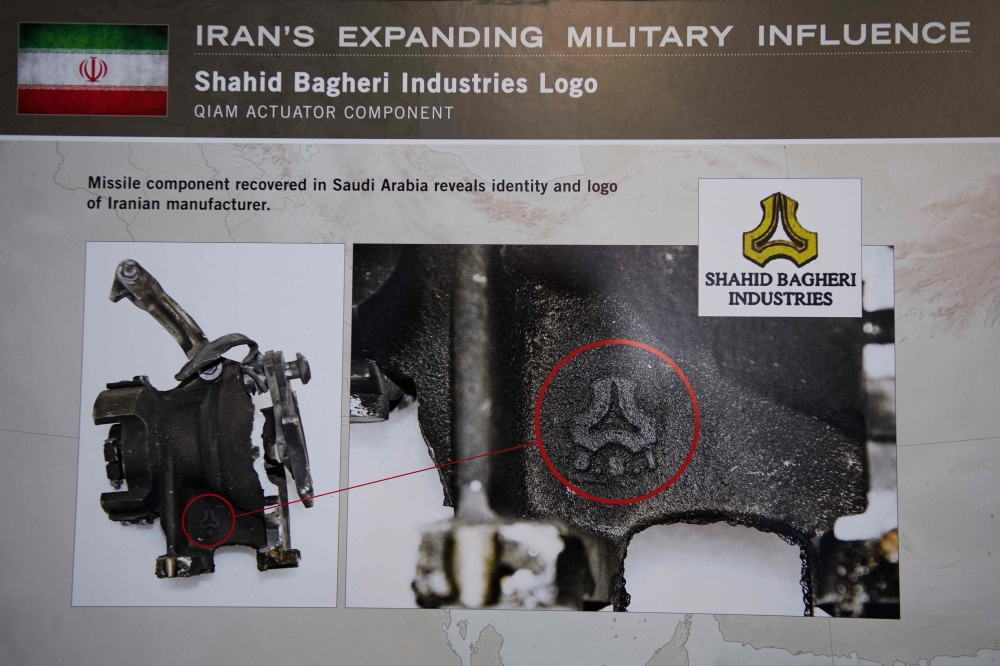
UNITED NATIONS — US ambassador to the United Nations Nikki Haley presented "concrete" evidence Thursday that a ballistic missile fired by Houthi rebels in Yemen at Saudi Arabia last month was Iranian-made, a charge Tehran immediately denied.
Haley accused Tehran of a "blatant violation" of UN Security Council obligations designed to reign in its missile activity, further stepping up the rhetoric towards Iran which Washington accuses of going against the spirit of a historic nuclear accord.
Standing in a warehouse at a Washington military base in front of pieces of a missile, Haley said Iranian fingerprints were all over the weapon that was fired at Riyadh's airport on Nov. 4.
"It was made in Iran then sent to Houthi militants in Yemen," Haley said.
"From there it was fired at a civilian airport with the potential to kill hundreds of innocent civilians in Saudi Arabia."
Alireza Miryousefi, spokesman at Iran's mission to the United Nations, said Tehran "categorically" rejects the US claims.
"This purportedly evidence, put on public display today, is as much fabricated as the one presented on some other occasions earlier," he said.
Haley has called on the UN Security Council to take a tougher stance toward Iran, accusing Tehran of making illegal arms deals in Yemen, Lebanon and Syria.
A confidential report to the council says UN officials had examined debris from missiles fired at Saudi Arabia which pointed to a "common origin" but there was no firm conclusion as to whether they came from an Iranian supplier.
Haley said the missile was an Iranian Qiam-class short-range ballistic missile and pointed to valves that she said proved its origin. The Qiam-1 is based on a modified Scud design.
"Today's revelations proved yet again that Iran's dangerous presence in the Middle East is only growing despite their attempts to deceive the world," Israel's ambassador to the UN Danny Danon said in a statement.
"The threat of Iranian missiles stretches from the Arabian Gulf, through Yemen, Syria and all the way to Lebanon and Gaza."
The report from UN Secretary-General Antonio Guterres, which was obtained by AFP, said the officials were still analyzing the information.
A separate team of UN experts who inspected the missile fragments during a visit to Riyadh last month found a possible link to an Iranian manufacturer, the Shahid Bagheri Industrial Group, which is on the UN sanctions blacklist.
The experts, who report to the sanctions committee, found a component marked by a logo similar to that of the banned group, which is a subsidiary of the Iranian Aerospace Industries Organization.
In his report, Guterres said officials had seen the logo but that they were still analyzing the information.
Earlier, Reuters was given advanced access to the military hangar at Joint Base Anacostia-Bolling just outside of Washington where the US Defense Department put the fragments of weaponry on display and explained how it concluded that they came from Iran.
The arms included charred remnants of what the Pentagon said was an Iranian-made short-range ballistic missile fired from Yemen on Nov. 4 at King Khaled International Airport outside Saudi Arabia's capital Riyadh, as well as a drone and an anti-tank weapon recovered in Yemen by the Saudis.
Iran has denied supplying the Houthis with such weaponry.
"The US has long believed that Iran is providing weaponry to proxies and partners and militias throughout the region, and what we have here to show you today is proof," said Pentagon spokeswoman Laura Seal, adding Saudi Arabia and the United Arab Emirates had recovered the arms and loaned them to Washington.
The unprecedented presentation by the Pentagon is part of its follow-through on President Donald Trump's new Iran policy, which promises a far harder line toward Tehran. — Agencies